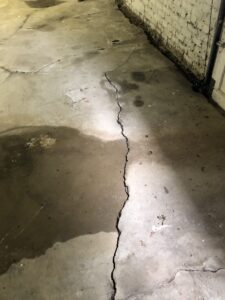When finishing your basement, the two most important problems to address are high humidity and standing water. High humidity leads to mold and fungal growth on your walls, furniture, ceiling, and more. Standing water can also cause mold as well as termite damage.
Best Sump Pump for Basements
https://crawlspaceninja.com/blog/best-sump-pump-for-basement-waterproofing/
Basement Finishing Tip #1: Waterproof the Floors
I’m leading with the waterproofing the floor tip because it is never discussed and you may be rolling your eyes. When we finished our basement, we installed tile flooring. I am not a fan of other flooring materials in a basement, bathroom, or kitchen. I feel tile flooring or maybe waterproof vinyl flooring are the best options, but if your budget allows, go with tile. That being said, that is not what I mean by waterproof the floors.
Waterproofing the floors of your basement includes:
- Concrete crack repair.
- Properly installed interior drain system that addresses water under the slab, not just at the cold cove.
- Dimple membrane floor covering for tile or other flooring to install over.
What is Concrete Crack Repair
Your basement floor is cracked. So are your garage floor and your driveway. Some concrete cracks are severe and allow water to enter via hydrostatic pressure while others do not. Most cracks, even just cosmetic concrete cracks, allow humidity to enter your home. This humidity that enters the concrete crack can damage many flooring materials located in the basement.
5 Basement Waterproofing Tips
https://crawlspaceninja.com/blog/5-basement-waterproofing-tips/
Installing a basement dehumidifier may not address concrete crack humidity. The humidity from concrete cracks must pass through or touch the installed flooring before the dehumidifier removes it. This can damage the materials regardless of humidity control.
Properly Installed Interior Waterproofing Drain System
There are a lot of interior waterproofing products on the market today. Many of them only address water at the cove joint of the basement. The cove joint of the basement is the area where your basement floor meets the foundation wall.
Water enters usually from 3 areas:
- The cove joint
- Under the footer
- Concrete slab
Installing an interior waterproofing system like the Crawl Space Ninja’s Hydraway System is one way to ensure water is directed to the waterproofing system from all areas of the basement. The Hydraway System allows water to enter no matter what the source. Even water entering the foundation wall above the system is directed into the Hydraway via wall waterproofing barrier.
Basement Waterproof Floor Covering
Finally, you want to make sure you install a waterproof dimple floor covering before installing your flooring. If you are installing tile you should not need a waterproof underlayment, but if you are installing carpet, laminate, vinyl or hardwood, we recommend the DMX products. However, as I said earlier, tile would be my first choice in a basement finishing project. Installing the DMX product will also help keep your floors warmer.
Do you need help with your basement waterproofing project? If so, please contact Crawl Space Ninja and we will be glad to help. Also, let us know in the comments below if you’d like to suggest a future blog post.
Visit our DIY Store
Contact us if you need help fixing your crawl space, basement, attic, duct-work, foundation repair, or yard drainage by clicking here.
Learn about Crawl Space Ninja Franchise opportunity.



2 thoughts on “Basement Finishing: Steps for Finishing Your Basement”
In a very humid basement, I’m sure metal studs and mold resistant dry wall is preferred. What about insulation/vapor barrier/ air gap from cinder block wall to framed wall? Lord of conflicting information online from Carrie’various resources.
Hi Jordan, we insulate basements here in several ways. Fir strips with foamboard between. Build out a stud wall (wood/metal) from the foundation and install batt insulation and some will spray foam. I have seen vapor barrier on walls but usually it is attached over the fir strip and insulation to trap moisture between it and the foundation wall which is not good. If it were my home and you have foundation moisture coming through the basement wall. I would install an interior waterproofing system and plastic up the wall to drain water into it. Just throwing up plastic with no where for the water to go could allow it to leak onto your subfloor. Then I’d frame out the wall as to not puncture the plastic and insulate between the joists. Then put up your finished wall material. Hope that helps.